Yard Ramp | Yard Ramps | New, Used, and Rental Forklift Ramps
Watch our yard ramp videos
Load/Unload Faster with a Copperloy Yard Ramp
The steel yard ramp from Copperloy is designed to operate faster and with more safety features than any other forklift yard ramp in the world. With our competitive pricing and short lead times, expanding your shipping capacity with portable forklift ramps has never been easier.
Yard ramps are essential tools for increasing your loading dock’s capacity without needing additional truck bays. They enable efficient freight transfer between semi-trucks and the ground using forklifts. A portable yard ramp can boost productivity by facilitating loading and unloading in locations without a dock, ensuring your drivers are back on the road swiftly, saving both time and money.
Our Yard Ramp Safety Features:
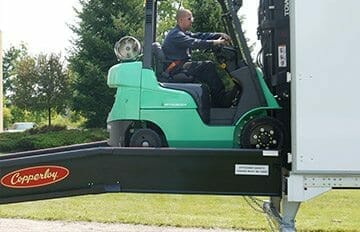
8ft level-off for trucks to safely enter and exit the trailer.
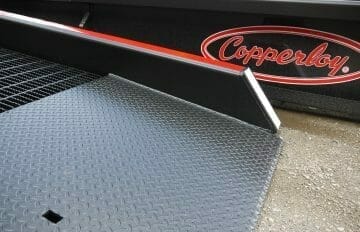
7″ safety curbs along the length of the yard ramp.
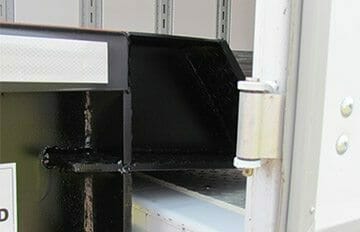
15″ lip designed to firmly rest the ramp on semi-truck container or platform.
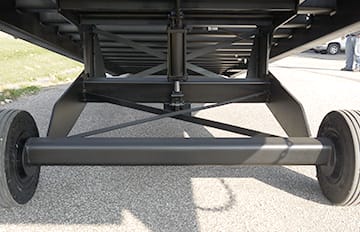
Increased stability with a central, one-cylinder design.
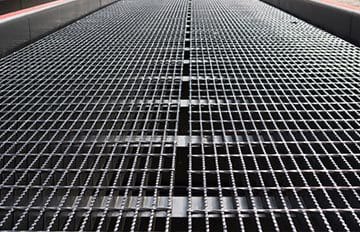
Increased durability with high-strength steel safety grating.
Yard Ramp Efficiency Features:

Fastest raise and lower speed with single hydraulic pump design.
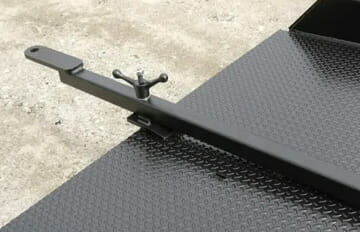
Easier maneuverability with a forklift tow bar.
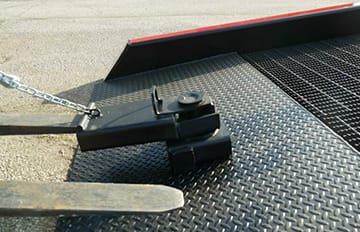
Speed up alignment with the trailer with the 180 degree positioning sleeve.
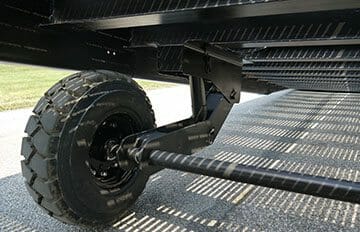
18″ solid pneumatic tires eliminate the maintenance of traditional tires.
Engineered for Fast, Safe Truck to Ground Loading and Unloading
Utilize a Portable Yard Ramp For Improved Loading Efficiency
What is a Yard Ramp? | Yard Ramp Benefits | How Do Portable Yard Ramps Work? | Features | FAQs | Rent a Yard Ramp
Copperloy yard ramps are engineered to maximize space, productivity, and safety with durable construction and several special features. Made in the USA, our one-cylinder ramp design is more stable and uses less pressure to lift the ramp compared to traditional yard ramps with two-cylinder hydraulic systems.
Our enhanced design features deliver:
- Easier operation – The pump location on the outside of the yard ramp frame allows for more convenient access.
- Faster raise times – Vertically position the ramp up to two and a half times faster than the average ramp.
- Less wear and tear – Rotation occurs on the redesigned positioning sleeve instead of the ramp connection, reducing wear on the ramp structure.
- Greater stability – The centrally located cylinder keeps the ramp stable while raising and lowering which means less chance of tipping.
- Solid-filled pneumatic tires – Better handling on rugged terrain while eliminating issues like punctures or air pressure problems.
Learn about the capabilities of Copperloy Yard Ramps!
Copperloy has a wide selection of yard ramp sizes and capacities to fit your requirements. With new, used, and rental purchase options available anywhere in the US, Copperloy can deliver the ideal ramp to fit your budget. For more details on the available sizes of our yard ramps, specifications, and weight capacities, contact the Copperloy team or view the chart above. The Copperloy team can assist you in finding the perfect model for your facility and application.
What is a Yard Ramp?
A yard ramp, aka yardramp or yard dock ramp, is essentially a fully mobile loading dock. It provides ground-level access to your loading dock and semi-truck trailers and a level surface for transporting materials. They are often called portable loading docks because they can create freight-hanlding centers in nearly any location. Yard ramps are often used in combination with existing loading docks to expand their capacity without having to relocate to a larger warehouse.
The central advantage of a yard ramp is productivity. This equipment allows you to set up freight loading operations pretty much anywhere, so you can use more of your facility space to get more jobs done in less time. With extremely high weight capacities, yard ramps make heavy-duty freight handling much easier and safer, allowing forklifts to safely access shipping containers and truck trailers and perform tasks more efficiently. This not only protects any goods in transport but everyone working in your warehouse.
A yard ramp is a cost-effective way to streamline your supply chain and solve many day-to-day problems at your loading dock. Whether your current dock is at capacity or no loading dock at all, yard ramps will make freight handling easier than ever and help you get more jobs done in less time.
Daily and weekly shipments are a regular part of businesses in most industries. Most of your supplies, materials, and equipment will be delivered by a semi or box truck, and your business needs to be ready for shipments of nearly any volume. Being able to accommodate freight deliveries is a crucial part of your supply chain, and Copperloy yard ramps can maximize your productivity. Give us a call and speed up your deliveries today!

How Do Yard Ramps Work?
Copperloy yard ramps offer a quick and efficient way to a full functioning freight handling center within minutes. These portable forklift ramps use one-cylinder hydraulic systems to raise and lower to whatever height you need at speeds 2.5x faster than standard industry ramps. This single-acting system also allows the ramp to raise much more evenly than double-acting ramps, so your ramp is always level when you are ready to get to work.
Getting your forklift yard ramp into position just takes a few easy steps. Start by closing the pump release valve, slide the pump handle into the pump opening, and crank until it reaches the desired height. Use a forklift to move the ramp until the lip is completely over the trailer bed and open the release valve to allow the ramp to safely settle onto the carrier floor. Now, you just need to secure the ramp to the truck with the two included safety chains, and you are ready to get to work!
For a more comprehensive understanding of Copperloy yard ramp operation, check out our collection of specs, manuals, and brochures.
Yard Ramp Features

8-FOOT LEVEL OFF
The Copperloy mobile yard ramp has an 8-foot level off feature. This is necessary for forklifts to have easy access onto trucks, loading docks, and platforms. It allows the fork truck to safely enter the trailer at a level approach and without having to stop. This feature makes for a very stable yard ramp and is especially useful on mobile ramps.

15-INCH LIP
The 15-inch lip is designed to firmly rest on the truck carrier body, dock floor or platform. Our mobile ramps come equipped with eight-foot-long safety chains. Chains join the ramp to keep it from pulling away.

HYDRAULIC PUMP
The single-acting hydraulic hand pump design requires half the effort needed to raise ramp compared to other mobile ramps. The pump is relocated so that it is protected away from dirt, debris, damage and makes maintenance easier to perform. The handle is stored out of the way when not in use.

SMOOTH SIDE PLATES
Smooth side plates and safety curbs are standard. They are constructed of high strength steel and enclose all working components, while also protecting them from possible damage from other equipment.

LOW END PLATE
We designed an end plate that is shorter than the wheelbase of most forklift trucks. This way, front-drive wheels can reach high-traction grating, while rear wheels are still on the ground. The plate comes standard with beveling from the underside and helps to provide an easy and smooth ground-level entry. It also eliminates jolts and bumps as the forklifts travel on and off the yard ramp, with or without a load.

DECK GRATING ON OUR YARD RAMPS
High-strength steel is standard on all Copperloy yard ramps. Grating bars are constructed for durability in the roughest of applications. The 1-3/4 inch bar depth allows snow, rain, and other debris to fall through. The serrated grating helps to ensure an all-weather, high-traction running surface.

SAFETY CURBS
7-inch high curbs are standard on all Copperloy ramps to help prevent accidental runoff with a patented box frame.

18-INCH SOLID/PNEUMATIC TIRES
The solid/pneumatic tires are standard on all steel Copperloy mobile yard ramps and are ideal for all applications. The tires are maintenance-free.

THE POSITIONING SLEEVE
The position sleeve allows the yard ramp to maneuver 180 degrees which reduces loading/unloading time and increases productivity. The fork slides into the positioning sleeve and the ramp can easily be positioned into place. The positioning sleeve is included with all steel mobile yard ramps. The sleeve is not intended for long-distance towing.

TOW BAR
A tow bar is an option on both steel and aluminum mobile yard ramps that attaches to the lower end of the loading ramp. It allows the ramp to be towed a short distance (within your facility). A towable yard ramp can be maneuvered easily with a forklift. The max towing speed is 5-mph and is not intended for over-the-road towing.
Choosing the Right Yard Ramp for Your Loading Dock
What to choose from our selection of portable yard ramps depends on how you will be using them. Looking for a permanent loading area or do you require a portable loading ramp? What is the maximum weight that your lift trucks will be transporting? (Don’t forget to include the weight of the lift truck.)
Do you require dock-to-ground access or ground-level access to railcars and trucks? Copperloy has been manufacturing yard ramps for over 60 years and our staff is available to consult with you on the best solution for your loading application.
Dock crews prefer Copperloy because our yard ramps are faster and easier to position than any other ramp on the market and have been proven to outperform other manufacturers including Bluff Manufacturing, Vestil, Discount Yard Ramps, and Handiramp. If you’re not sure of your future needs, consider a rental yard ramp or a used yard ramp. All Copperloy used ramps are factory certified and guaranteed.
Check out our selection of steel and aluminum portable yard ramps below:
Types of Yard Ramps
Create a Portable Dock Anywhere with Mobile Yard Ramps
Companies can create a dock anywhere with a mobile yard ramp by easily converting open yard space into a portable loading dock. Yard ramps provide a safe, efficient method to load/unload freight with forklifts and access the back of the truck. A steel yard ramp is a cost-effective way to expand freight handling capacity beyond the physical loading docks in a facility.
Portable Yard Ramps
The yard ramp acts as a portable loading dock ramp and an ideal solution for shipments that need to go from ground level to the truck and a fast method to unload a truck to the ground. Copperloy offers both aluminum ramps and steel ramps depending on your weight and application requirements. Rentals are available and ideal for short-term projects.
Portable Steel Yard Ramps
The Copperloy portable steel yard ramp is available in different base materials. However, steel is the standard base for steel yard ramps. As a leader in custom steel fabrication, Copperloy has mastered the craft of high-strength steel specifications and integrated features such a serrated steel grating for added traction. Manufactured in the USA, steel ramps are built for durability and made to last.
Dock-to-Ground Ramps
Our dock-to-ground yard ramps provide a stationary, semi-permanent solution and are typically fixed to the dock for fast, efficient loading/unloading solution handling weights up to 30,000 lbs. Copperloy dock-to-ground ramps are a safe, versatile way to expand the capability of your loading dock.
Ground-to-Truck Yard Ramps
Ground-to-truck ramps allow for easy ground-level access to semi-trucks. Copperloy yard ramps allow for maximum safety and productivity when unloading and loading. Designed for industrial use, ramps are available in aluminum or steel based on your material handling requirements.
Heavy-Duty Portable Loading Docks with Dock Platforms
For facilities with limited space or no permanent dock exists, portable loading docks can provide a cost-effective solution for parallel loading when used with dock-to-ground or yard ramps. Copperloy’s portable loading platform features durable steel construction that can handle capacities up to 60,000 pounds. Their unique design allows lift trucks to easily make right-angle turns. Multiple portable loading docks can be connected when larger portable loading docks are required.
Applications of High-Capacity Yard Ramps
Typical uses of our heavy-duty, high-capacity steel yard ramps include:
- Industrial equipment applications
- Construction equipment, machinery, and supplies
- Flatbed truck unloading/loading
- Military applications such as loading military vehicles and equipment
- Tractors, skid steers, bobcats, and other heavy equipment
- Heavy equipment rentals
- Warehouse equipment
- Car and vehicle ramps
Portable Yard Ramp Safety
Although Copperloy portable yard ramps are designed with safety features, operating a forklift on a ramp should be done with the utmost caution. Prior to using the ramp, it is important to thoroughly review the owner’s manual. Only trained personnel should operate the ramp.
It is extremely important to ensure that the ramp is properly secured before loading and unloading tasks. View the owner’s manual for a full overview of instructions and precautions. We also recommend reviewing the OSHA ramp guidelines.


















